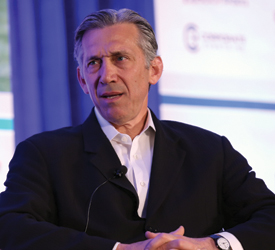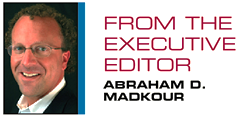Iknow I speak for everyone at our sports business group when I say we were heartbroken over the events last Monday at the Boston Marathon. Over the week, we developed stories in SportsBusiness Daily/Global and in this week’s SportsBusiness Journal that examine the legacy of this horrific event. The tragedy that struck such a joyous, communal, organic event that truly is a rite of spring for an entire region will leave an indelible mark on the sports industry and the way events are organized and operated. Sadly, it’s a story that will be a consistent thread through our publications going forward.
■ NORTH SIDE UPSIDE: One of the projects I’ll be keeping a close eye on is the $500 million renovation of Wrigley Field and its surrounding area. To me, this represents one of the best examples and opportunities in urban renewal and development in sports, with a unique canvas to renovate a historic building that will have to co-exist and conform with a new hotel and office space.
This is a tremendous opportunity for the Ricketts family, who handled the challenges of Chicago politics to reach this agreement with the city and are contributing $300 million to the ballpark and $200 million to develop the hotel and office building. Sure, this project could be dragged down by lawsuits, but when it moves forward, the family can bring all of its assets and ideas — as well as the history of the Cubs and the area — to a truly transformational project.
Before this deal with the city was complete, I caught up with Tom Ricketts at our World Congress of Sports, and it was apparent how vital this plan was to the future of the franchise. And he made it clear that it all starts with Wrigley. “We’re going to save the park,” he said, “It’s an institution that everyone loves. We are going to do what needs to be done to make sure that it’s there for the next generation of fans. The same park that your grandfather took you to, you can take your grandkids to.”
But he also stressed the plans included much more than that and offered a way to leave a positive mark on the area. “We are re-imagining what can be done around the park,” he said. “We have some land on the west side of the park [where] we are going to create an open plaza and bring in events that are really positive for the community.”
“Wrigley is in a real neighborhood. People are raising their families there and we’re sensitive of that. I used to live in that neighborhood. I used to live across the street. We just see that there is so much opportunity to do something fun and engaging and value-added around the park, with a lot more than the 81 dates that we have a game. We think of it as potentially a town square for the north side of Chicago, and that’s our vision.”
It’s certainly similar to the changes we’ve seen at Fenway Park and Yawkey Way over the years. It’s a rare mixed-use urban development opportunity in sports and a unique situation that any team, brand and developer will want to watch closely. It includes basic ballpark improvements, with revenue/signage and branding opportunities with development outside the venue and embedded in a neighborhood. I am looking forward to getting a better sense of the team’s plans when we host our Activation Summit in Chicago and take in a White Sox-Cubs game at Wrigley on May 29. Hope you’ll have a chance to join us.
■ DO YOU HEAR THEM?: A few weeks ago I wrote about Atlanta Falcons President Rich McKay telling how his boss, team owner Arthur Blank, constantly pushes his staff to listen better to actual fans before making decisions related to the customer experience. Don’t just listen to your cohorts and staff — listen to the people. I thought I’d relay a similar story as I clean out my notes from World Congress.
 |
“Are we asking the right people? … I think the fans and what they do tell us more than anybody else.” -- Eric Grubman
Photo by: GORT PRODUCTIONS
|
The notion of listening to fans may seem a cliché and a simple exercise, but if enough smart people continue to express it, it pushes me to think that it’s being overlooked and given lip service. At a panel discussion, the notion of innovation in sports and being “fan friendly” was brought up a few times before
Eric Grubman, NFL executive vice president and president of NFL Ventures, forcefully chimed in, “Are we asking the right people? Because in my experience, we’ve generally asked ourselves and we’ve asked our owners. And I think the fans and what they do tell us more than anybody else.”
He gave a few examples of how fan behavior started patterns: “If you go to a Steelers game, they didn’t build any standing room of any significance. Those people do that, on that spiral stair walk up, where they watch the game. They’ve carved out their standing room. If you go to an Eagles game, a certain group of people go to those corner places that were not built for standing room, they were built for mix, and now they’ve become de facto pavilions.
“We know what content people want; we know how different people want to interact with the games. So why are we building a bricks-and-mortar stadium or bricks-and-mortar venue with the thinking of how people wanted to watch a game? We’ve done great things with the architecture and great things with ingress and egress, but why haven’t we done as great things with the basic structure of how someone watches an event? Because we haven’t asked the right people, the fans. And the fan today I know is different than the fan of 25 years ago. They grew up in a different environment.”
Anheuser-Busch’s Blaise D’Sylva immediately followed up: “It’s a fundamental part of what goes wrong in this business. We don’t ask the consumer what they want, we do what we think they want and/or what is going to make money.”
Said WTA Tour CEO Stacey Allaster: “In our sport, we’re not very consumer friendly at all. We tell them to be quiet, we tell them to sit down, we tell them they can’t get up, you can’t come into the stadium in between the match. I couldn’t agree more with Eric that we don’t ask the right people. We, ourselves, are always thinking about the players, we’re always thinking about the tournaments, and we rarely as an organization think externally and think about our fans.”
This exchange raised a few eyebrows and was mentioned in discussions after the session, with more than a few commenting that it would cause them to revaluate their “listening” process.
It all sounds trite and obvious, but at times, we may be so out in front, we forget the basics. That’s why social media is such a powerful tool, as it brings people closer to the decision-making process and offers everyday fans the ability to become involved and engaged in a process.
One example of this: Alexandra Wheeler, Starbucks vice president of global digital media, said at the Ad Age Digital Conference that its social engagement program, “My Starbucks Idea,” has led to 281 new ideas that have been implemented and activated at the chain.
But that’s still just one way of listening, and I share these comments only in the spirit that, in this age of modern research and analysis, all of us in sports need a reminder to step back and listen more — and better — to the people who truly matter.
Abraham D. Madkour can be reached at amadkour@sportsbusinessjournal.com.





